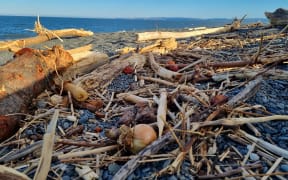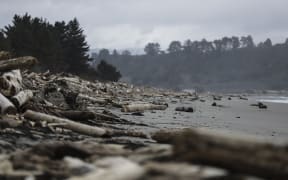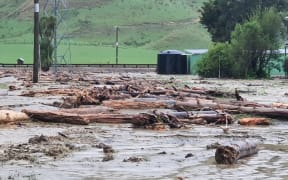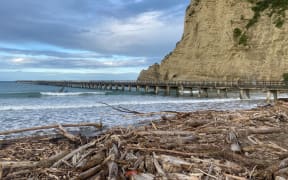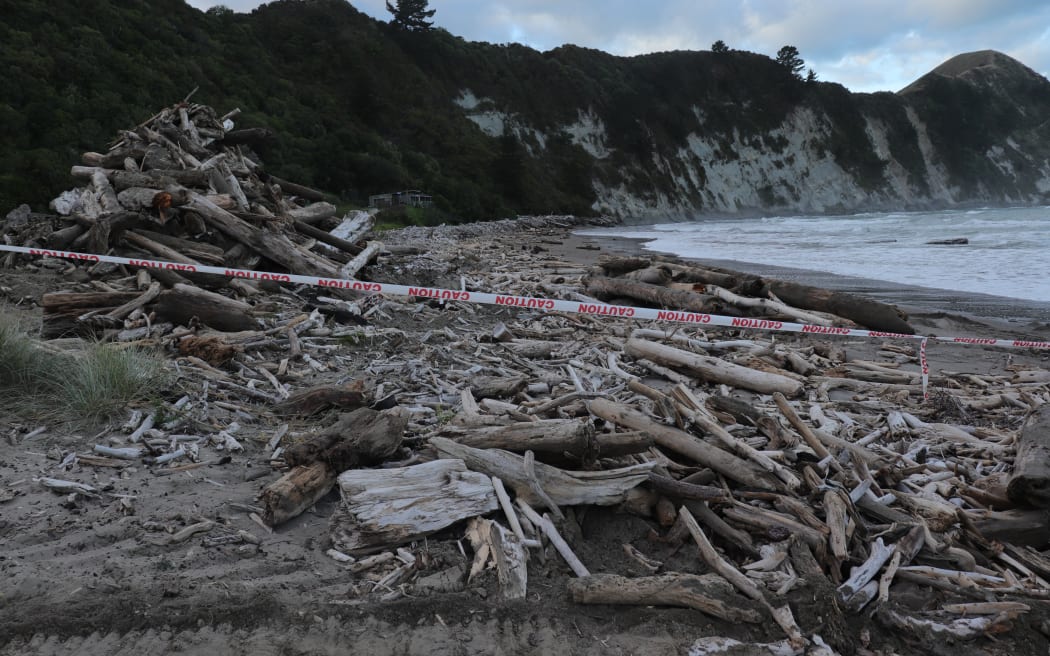
Slash in Tolaga Bay in 2021. Photo: RNZ / Tom Kitchin
A third large scale beach clean-up funded by two major forestry companies has begun at Tolaga Bay.
During Cyclone Gabrielle, coastlines were inundated with forestry byproducts like slash and whole trees were washed away by swollen rivers.
More than two months later the beaches were still covered in woody debris.
Slash has been an issue in Tai Rāwhiti for years but Cyclone Gabrielle brought the extent of the problem into the spotlight, and a ministerial inquiry was announced by the government in late February.
Forestry companies Aratu and Ernslaw were funding the Tolaga Bay clean-up, which was co-ordinated by the Eastland Wood Council.
Eastland Wood Council chief executive Philip Hope said the three companies primarily resourcing the clean-ups were Aratu, Ernslaw and PF Olsen.
Although it was not entirely the fault of the forestry industry for the state of the beaches, the forestry companies were undoubtedly best placed to deal with it, having the machinery and expertise already, he said.
"This clean-up in Tolaga Bay, at the north end of the beach, will be the third one to date," Hope said.
"That will continue through until that beach is removed of all the wood debris and then they'll be starting on the south end of the beach."
Hope said he had also asked Gisborne District Council to disclose a list of forestry companies operating in the area who were not currently members of the Eastland Wood Council or affiliated with these cleanups.
"Our industry clearly believes that if they are harvesting in areas which are impacting waterways and beaches, they most definitely share a responsibility in mobilising the clean-up."

In Tairāwhiti, farmers near Tolaga Bay saw forestry slash and land damage from winds and heavy rain as a result of Cyclone Gabrielle. Photo: Supplied / Bridget Parker
On a normal year, the council would be responsible for cleanups.
Gisborne mayor Rehette Stoltz said they usually only did one, just before Labour Weekend, which marked the start of summer.
"Everything that's come over winter is removed and tidied up, we don't usually have as much as we've seen in the last few years, but usually it's ratepayer funded - we budget for it, and we tidy up."
Each clean-up cost $60,000 to $70,000, she said.
But the past year had seen more storms and more debris, stretching the council beyond what it could afford.
"Then we had a [storm] event in November, and the beaches just looked like nothing had been done, so then before Christmas again we paid a huge amount of money [to clean up]."
Then came Cyclone Gabrielle, and Stoltz said the forestry companies had responded well to the council's expectations about their role in the clean-up.
However, bad weather events brought more slash onto the beaches, and seemed to replenish it after each clean-up.
In January, a boy died at Gisborne's Waikanae beach after being hit by a floating log, and last week, Juliana Marston slipped while playing on the beach and was crushed by a log, breaking her pelvis.
Her father, Clint Marston, said she was discharged from hospital on Saturday night, and was recovering ahead of schedule.
But she was still using a wheelchair and a walking frame because of her fractured pelvis.
"Being a byproduct of an industry that makes a huge amount of money, to me, [the clean-up] should be fully funded by the forestry industry," Marston said.
He said with one child dead and another seriously injured, it was time to demand better practises from the forestry industry.
